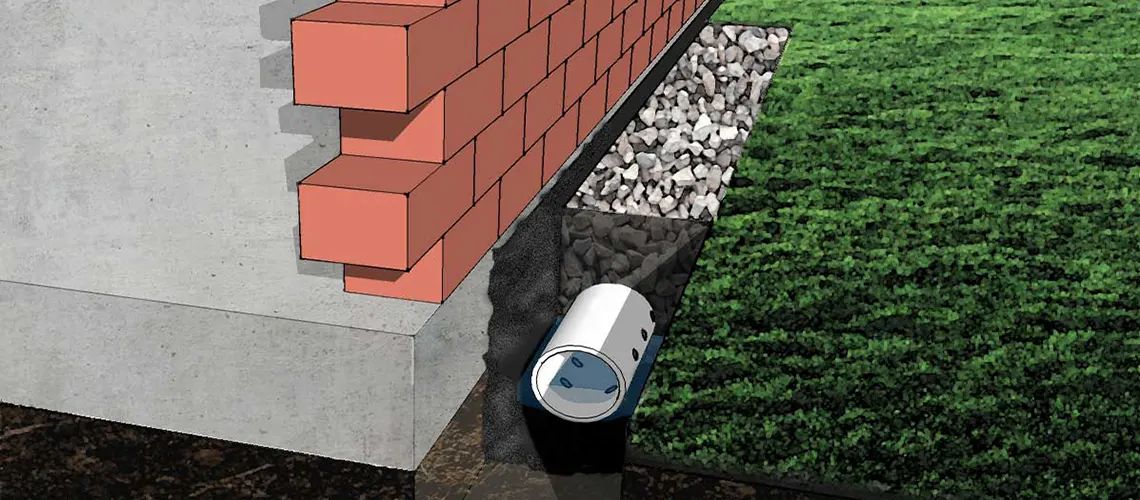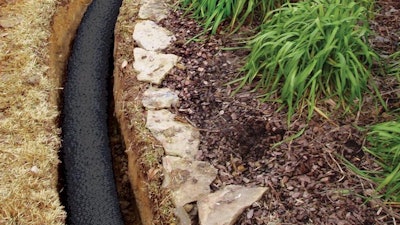The Necessary Overview to Keeping Your French Drain for Resilient Efficiency
Preserving your French drain is crucial to its effectiveness and your property's defense. Normal checks can save you from pricey repair services and water damage. You'll need to know what indicators to seek and exactly how usually to examine your system. And also, understanding the cleansing procedure can make a substantial distinction. Let's explore the necessary steps for ensuring your drain works well for years to come.
Comprehending the Function of a French Drainpipe
A French drain is an important component in handling water around your home. It directs excess water far from your structure, avoiding flooding and damages. When hefty rainfall falls, the drain gathers water with a perforated pipeline buried in gravel. This system enables water to stream easily, lowering stress on your cellar wall surfaces and reducing the danger of leaks.You may wonder how it operates in technique. As water saturates the soil, gravity draws it towards the drainpipe. The perforated pipeline captures this water, moving it to an assigned water drainage area or storm drain. This process maintains your lawn completely dry and protects your home's structural integrity.Understanding just how a French drainpipe features is essential to valuing its relevance. By properly directing water away, it assists maintain a dry and secure living setting. Keeping your French drain in top condition assurances you prevent expensive repairs down the line.
Regular Evaluations: What to Seek
When you're inspecting your French drainpipe, start by checking for any clogs that could be obstructing water flow. Focus on indications of surface area erosion around the drainpipe, as this can show possible concerns. Normal evaluations will help keep your water drainage system working effectively.
Obstructed Drainpipe Assessment
How can you inform if your French drainpipe is clogged? Initially, expect water merging in your lawn, specifically after heavy rain. That's a red flag if you discover areas where water collects instead of draining. You must additionally check the drain outlet; if water isn't moving out as it should, there's likely an obstruction. Listen for uncommon gurgling audios, which can suggest trapped air. Additionally, examine the drainpipe's surface area for any type of vegetation growth, as origins can obstruct the system and infiltrate. If you smell musty smells, it might aim to stagnant water created by a clog. Consistently reviewing these indications can assist you maintain your French drain efficiently and protect against expensive repair services.
Surface Disintegration Examine

Cleaning Your French Drainpipe: Step-by-Step Overview
Cleaning your French drain is crucial for keeping it operating correctly. You'll require some specific tools and a clear procedure to assure every little thing runs efficiently. Allow's walk through the steps and pointers for maintaining your drain properly.
Tools You'll Require
To deal with the task of cleansing your French drainpipe efficiently, you'll want to collect a few important devices. Get hold of a tough pair of handwear covers to protect your hands from debris and sharp things. A tiny shovel or trowel will certainly aid you remove dust or obstructions around the drainpipe. For cleaning out the interior, a plumbing's snake or a high-pressure water nozzle can be exceptionally beneficial. You'll additionally require a bucket for gathering any particles you draw out. Having a yard pipe on hand will certainly make it easier to wash out the drainpipe and guarantee it's streaming smoothly. With these tools all set, you'll be set for a comprehensive cleaning session!
Cleansing Refine Steps
Beginning by assessing the area around your French drain for any visible particles or blockages. Eliminate leaves, branches, or dust that might obstruct water circulation. Next off, check the inlet and outlet locations; clear any obstructions to guarantee proper drain. Use a yard hose to purge the drainpipe, routing water right into the inlet. This assists displace any kind of accumulated sludge or debris. If you discover persistent obstructions, think about making use of a plumber's snake to break them up. After cleansing, examine the gravel around the drainpipe; replenish it if it's gotten rid of. Validate the drainpipe covers are undamaged and firmly in location to avoid particles from getting in. Routine cleansing keeps your French drainpipe working successfully.
Upkeep Regularity Tips
While regular upkeep is necessary for your French drain's longevity, recognizing just how commonly to keep it can make all the distinction. Preferably, you should check your French drain a minimum of twice a year, ideally in springtime and autumn. After heavy rainfall or snowmelt, look for blockages or debris. If you see any our website standing water, it's time to cleanse your drain.In areas with heavy vegetation, even more regular maintenance-- regarding every three months-- may be essential. Additionally, take into consideration cleaning your French drainpipe after significant tornados or if you observe water pooling in your yard. By remaining aggressive, you'll assure your French drain functions efficiently and shields your building from water damages. Routine checks will certainly save you time and money in the long run.
Identifying Typical Issues and Their Solutions
It's crucial to recognize typical issues with your French drainpipe and execute reliable solutions when you discover water merging in your yard or damp spots in your basement. One frequent trouble is clogging, usually triggered by particles like leaves or debris. To fix this, you can utilize a plumbing serpent or a high-pressure water jet to clear blockages.Another issue might be inappropriate incline. If your drain isn't sloped properly, water will not stream far from your home. You can change the slope by digging and rearranging the drain pipe.Lastly, look for damages or splits in the drainpipe itself. Replacing the harmed sections is crucial for peak efficiency if you discover any. By addressing these issues immediately, you'll aid guarantee that your French drainpipe continues to function properly, shielding your home from water damages and preserving a dry, secure atmosphere.
Seasonal Maintenance Tips for Your French Drainpipe
Addressing usual concerns with your French drain is just the very first step in ensuring its long-term effectiveness. Seasonal maintenance is essential for peak efficiency. In the springtime, clear away leaves and particles that may have collected throughout winter season. Look for any type of obstructions in the outlet or catch basin, as water requires a clear path to flow freely.During summer, examine your drain for any type of signs of resolving or shifting dirt. Ensure it's still level and functioning appropriately. As loss techniques, clean any kind of dropped leaves to stop clogs prior to winter months arrives.In winter season, look for freezing temperatures. Make certain your drainpipe isn't at danger of freezing if you live in a cool environment. Shielding subjected pipes can help. Routine checks and timely maintenance can protect against expensive repair services and maintain your French drainpipe working efficiently year-round. Stay aggressive and enjoy comfort understanding your drain system is in great shape!
When to Contact a Professional
Understanding when to call a professional can save you time and protect against more damages to your French drainpipe. It's a clear indicator that your drainpipe might be obstructed or harmed if you discover persistent standing water in your backyard. Do not disregard unusual odors, as they can suggest sewer backup or decay, which needs immediate attention.If you discover that your drain isn't functioning properly after attempts to clean or preserve it, it's time to reach out for specialist aid. In addition, if you're uncertain concerning the underlying concerns or lack the required devices, working about his with a professional can offer peace of mind.Finally, if your French drain is old or has experienced significant damage, specialist analysis can identify whether repairs or full replacement is required. Trust fund the specialists to ensure your water drainage system functions efficiently for years to come.
Tips for Preventing Future Drain Problems
To maintain your French drainpipe working successfully, regularly checking and maintaining it can make all the distinction. Start by getting rid of debris, leaves, and dirt from the surface area and drain openings. This prevents obstructions that can bring about water backup. Examine the gravel around the drain; if it's compressed or deteriorated, consider adding fresh crushed rock to preserve perfect flow.Next, divert water far from your drainpipe by making certain seamless gutters and downspouts are clear and guiding water at the very least 3 feet far from your structure. Consistently check for any kind of signs of damages or sagging. If you observe concerns, address them immediately.Finally, think about setting up a filter or a catch basin to trap larger particles prior to it gets in the drainpipe. By remaining positive with these suggestions, you'll lessen the danger of future water drainage problems and keep your French drain in leading shape.
Often Asked Questions
For how long Does a French Drainpipe Commonly Last?
A French drainpipe generally lasts around 30 to 40 years, depending on the materials reference used and upkeep (Portland French Drain). If you stay on top of normal checks, you can extend its lifespan even additionally
Can I Install a French Drainpipe Myself?
Yes, you can set up a French drain yourself if you've obtained the right devices and expertise. Just ensure to intend meticulously, adhere to local laws, and warranty appropriate drain to prevent future issues.
What Materials Are Made Use Of in a French Drain?
You'll need perforated pipeline, gravel, landscape textile, and a strong drain pipeline for your French drainpipe. These products assist reroute water successfully, avoiding flooding and maintaining your property dry and safe from water damages.

Is a License Required to Install a French Drain?
You'll likely need a license to set up a French drainpipe, depending on regional laws. Get in touch with your municipality to ensure you adhere to any type of necessary guidelines and avoid prospective problems throughout installation.
What Are the Prices Connected With French Drain Upkeep?
Preserving a French drain usually sets you back between $100 and $500 every year. You'll require to consider expenses for cleaning, fixings, and inspections. Routine maintenance helps avoid bigger expenses and guarantees your system functions properly for several years - Portland French Drain. When you're examining your French drain, start by examining for any kind of blockages that may be blocking water circulation. By remaining aggressive, you'll ensure your French drainpipe features effectively and safeguards your residential or commercial property from water damage. When you see water merging in your yard or damp areas in your basement, it's crucial to identify common concerns with your French drain and apply effective solutions. You can readjust the slope by excavating and repositioning the drain pipe.Lastly, check for damages or splits in the drain itself. Inspect the crushed rock around the drain; if it's compressed or deteriorated, consider adding fresh crushed rock to preserve ideal flow.Next, draw away water away from your drainpipe by making certain downspouts and rain gutters are clear and guiding water at the very least three feet away from your foundation